Best
Capo
for
Beginners
String Capo DISCOVER NEW TONAL
POSSIBILITIES
-
Overall: Robust Zinc Construction
-
Best Feature: Maximum Width: 52mm
-
TedScore™:
8/10
Best
Capo for Steel
String Guitars
-
Overall: With A Stylish Finish That Will Complement Almost Any Guitar Finish
-
Best Feature: Has An Intuitive Design For Smooth Operation
-
TedScore™: 10/10
Best
Capo for 12-String Acoustic Guitars
Capo Acoustic SUPERB AND
DURABLE CAPO
-
Overall: Boasts Outstanding Durability With Its Aircraft-Quality Aluminium
-
Best Feature: Comes With Padding To Ensure Your Guitar's Safety
-
TedScore™: 9/10
Have you ever wondered, “Is it bad to leave a capo on a guitar?” — but before you make it a habit, let’s find out the mystery behind this common practice.
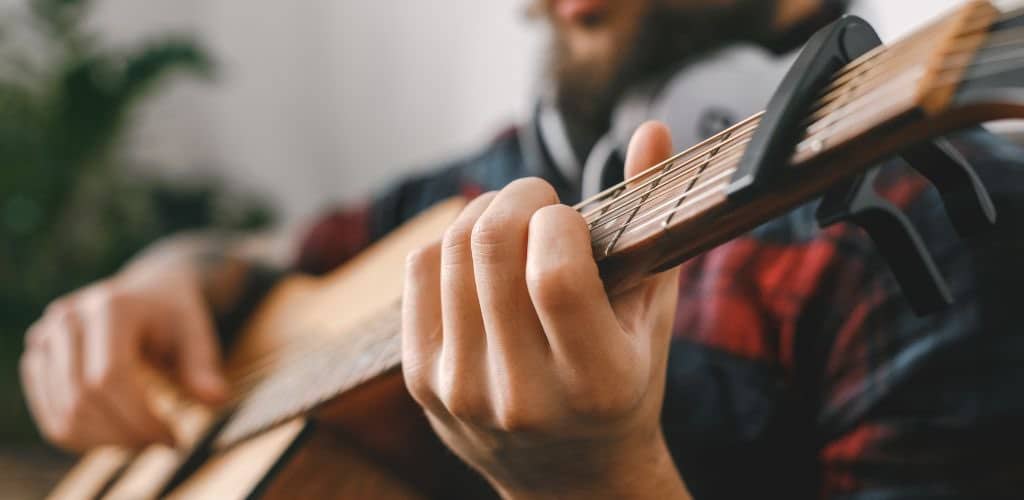
In this article, we’ll explore the potential impacts of leaving a capo on your guitar, from tuning stability to fret wear, ensuring you keep your instrument in top shape.
We’ll also share tips on how to use a capo effectively without compromising your guitar’s health. By the end, you’ll know exactly how to treat your guitar right while enjoying all the benefits a capo has to offer.
What Does a Capo Do, Anyway?
Before we reveal the potential pitfalls of leaving a capo on, let’s quickly recap what a capo actually does.
Changing the Key: A capo allows you to change the key of your guitar without having to learn new chord shapes. It’s like having a magical key that unlocks different musical doors!
Easier Chord Shapes: By placing a capo on a fret, you can play easier chord shapes while still achieving the desired pitch. This is especially handy for beginners or anyone who wants to avoid the dreaded barre chords.
Creating New Sounds: A capo can enhance your musical expression by giving familiar songs a fresh sound and a new twist. It’s like dressing your guitar in a striking new outfit!

The Risks of Leaving a Capo On:
Fret Wear
Now that we’ve established what a capo does, let’s address the elephant in the room: the potential downsides of leaving it on your guitar for too long.
String Pressure: Leaving a capo on can create constant pressure on the strings. Over time, this can lead to tuning issues and may even cause the strings to wear out more quickly.
Neck Relief: The constant pressure from the capo can affect the neck relief of your guitar. If the neck is under too much tension, it may warp or bow, leading to intonation problems and more significant issues down the line.
Fret Wear: A capo can create uneven wear on your frets, especially if it’s left on for extended periods. This can lead to buzzing or dead notes when you finally take it off.
Rubber Residue: Depending on the material of your capo, leaving it on can lead to rubber residue on your strings and fretboard. This can affect the tone and playability of your guitar.
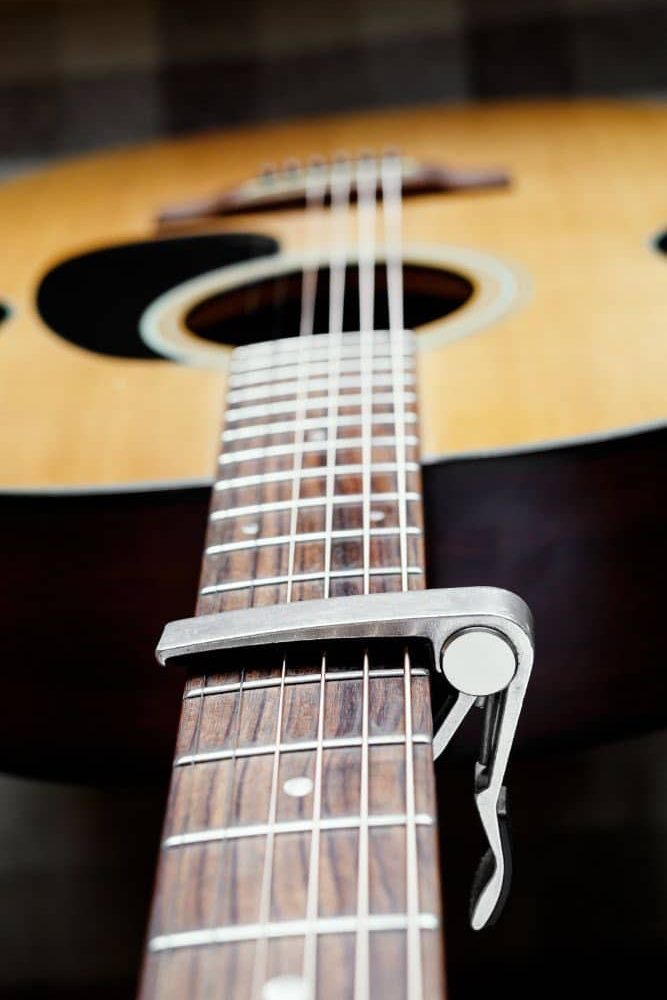
Impact on Guitar Strings
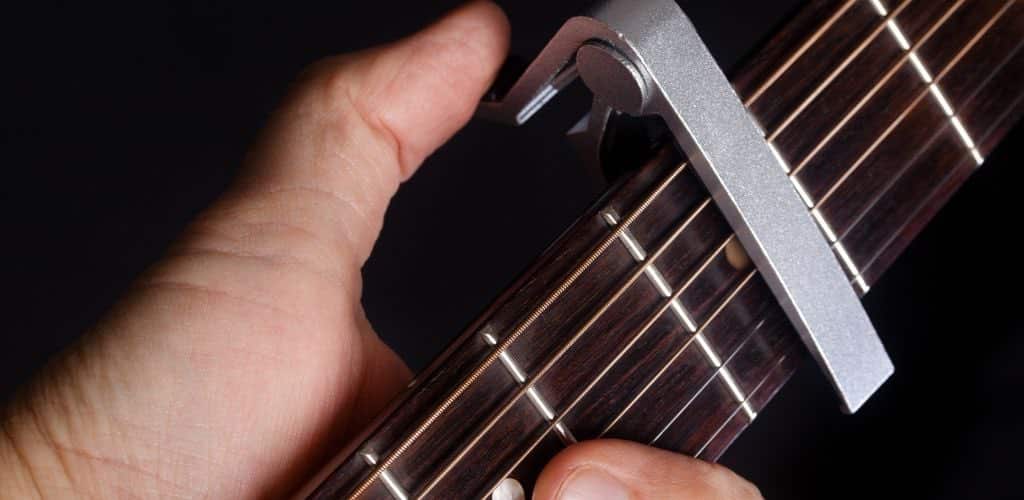
Using a capo can have a significant impact on your guitar strings. When a capo is clamped onto the guitar neck, it can cause unnecessary wear on the strings, particularly if it’s left on for an extended period. This can lead to premature wear on the wound strings, which can affect the overall sound quality of your guitar.
Additionally, if you’re using a capo to play barre chords, it can cause the strings to vibrate differently, which can put additional stress on the strings.
However, this is not a big deal, and most guitar strings can withstand the pressure of a capo. To minimize the impact on your guitar strings, it’s recommended to take the capo off when you’re finished playing and store your guitar in a guitar case or on a guitar stand.
Protecting the Guitar Neck
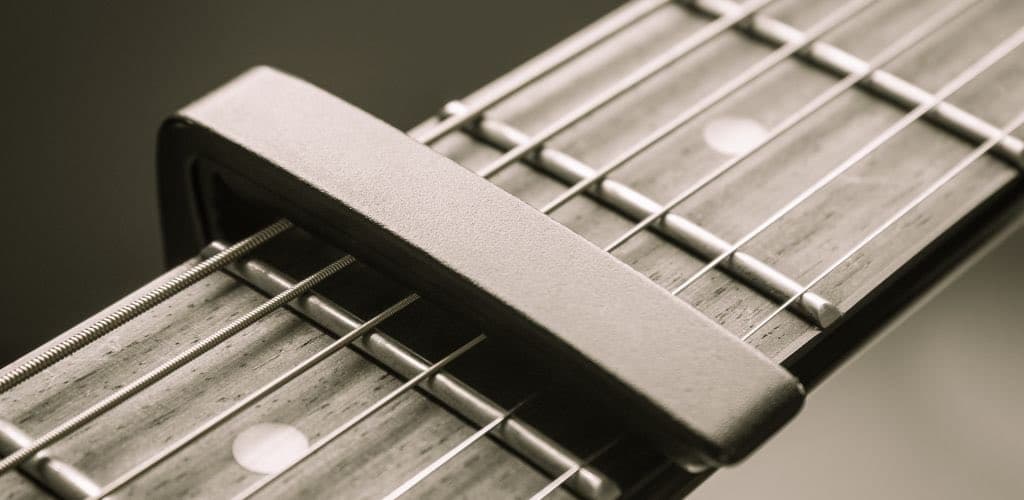
Leaving a capo on your guitar neck for an extended period can cause damage to the frets and fretboard. The constant pressure of the capo can leave marks on the fretboard and cause fret wear, particularly on the first fret.
To protect your guitar neck, it’s essential to take the capo off when you’re not playing. If you need to leave the capo on for a few seconds, make sure to adjust the tension to minimize the pressure on the frets.
You can also use a variable tension capo, which can help distribute the pressure more evenly across the fretboard. By taking these precautions, you can prevent unnecessary wear and tear on your guitar neck.
Best Practices for Capo Use

So, what’s a guitarist to do? Here are some best practices for using a capo without causing harm to your beloved instrument.
Remove When Not in Use: The simplest solution is to remove the capo when you’re not actively playing. This reduces the risk of string and neck issues, keeping your guitar in tip-top shape.
Use a Quality Capo: Invest in a high-quality capo that won’t damage your strings or fretboard. Look for one with a gentle grip and soft padding to minimize any potential harm.
Check Your Guitar Regularly: If you do leave your capo on for a while, make it a point to check your guitar for any signs of wear or warping. A quick inspection can save you from larger problems later.
Adjust Your Setup: If you frequently use a capo, consider having your guitar set up by a professional. They can perform tension adjustment on the neck relief and action to accommodate the additional tension from the capo.
Using a Variable Tension Capo
A variable tension capo is a type of capo that allows you to adjust the pressure on the strings. This can be beneficial in preventing damage to the frets and fretboard. When using a variable tension capo, make sure to adjust the tension to the minimum required to achieve the desired pitch.
This will help minimize the pressure on the frets and prevent unnecessary wear.
Additionally, a variable tension capo can help you achieve a more precise pitch, which can be beneficial when playing complex chords or melodies.
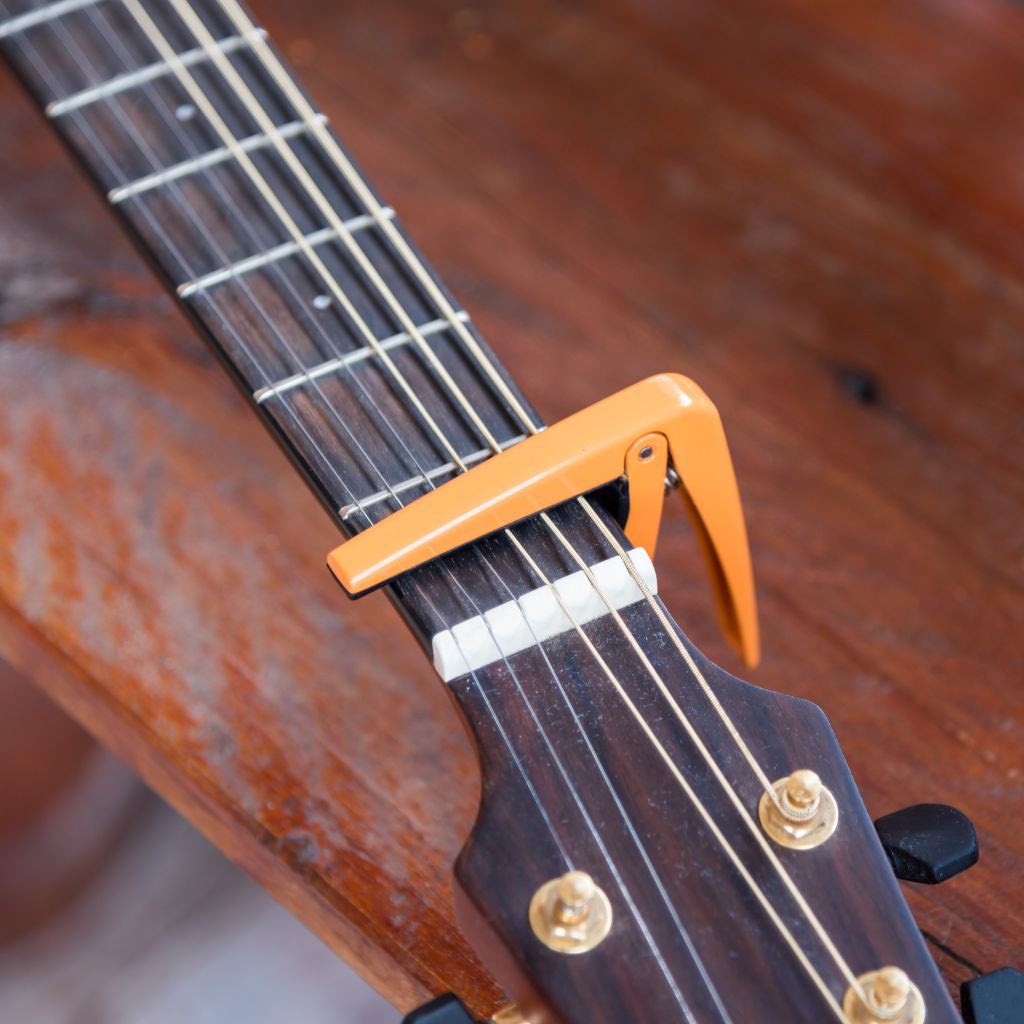
Storing Your Guitar with a Capo
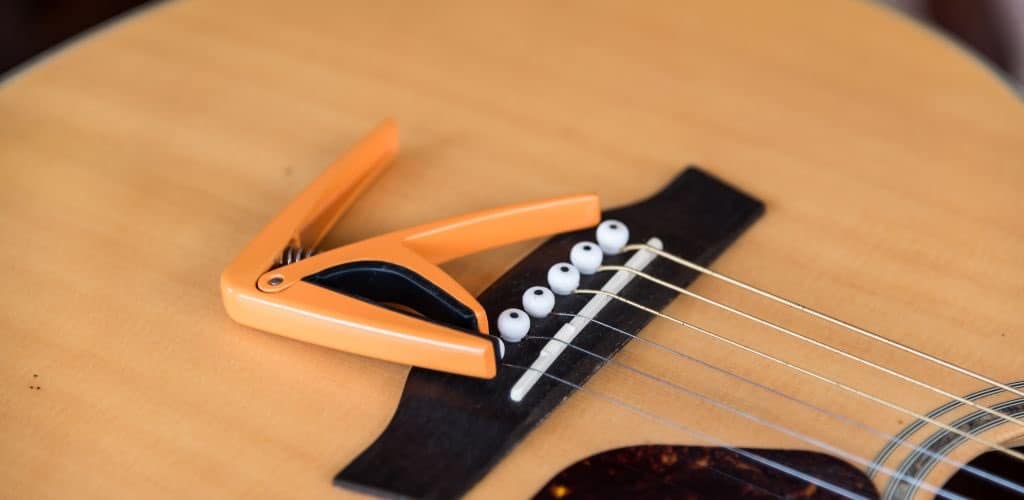
When storing your guitar with a capo, it’s essential to take a few precautions to prevent damage to the frets and fretboard. First, make sure to remove the capo from the guitar neck and store it in a separate compartment or case.
If you need to leave the capo on the guitar, make sure to adjust the tension to the minimum required and store the guitar in a guitar case or on a guitar stand. This will help prevent unnecessary wear and tear on the frets and fretboard.
Additionally, make sure to clean and maintain your guitar regularly to prevent dirt and grime from accumulating on the frets and fretboard. By taking these precautions, you can ensure that your guitar remains in good condition and continues to sound great.
The Pros of Using a Capo
Despite the potential downsides, there are plenty of reasons to love your capo. Let’s take a look at some of the benefits!
A capo allows for a wide range of musical expression. You can easily switch keys and experiment with different voicings, making it a valuable tool for songwriting and performance.
For beginners, a capo can make playing songs easier and more accessible. It opens up a world of music without needing to master complex chord shapes right away.
Sometimes, all it takes is a capo to inspire new ideas. Changing the key can lead to fresh melodies and arrangements that you may not have discovered otherwise.
If you’re jamming with other musicians, a capo can help you quickly adjust to different keys. This makes it easier to play along and keep the groove going without missing a beat.
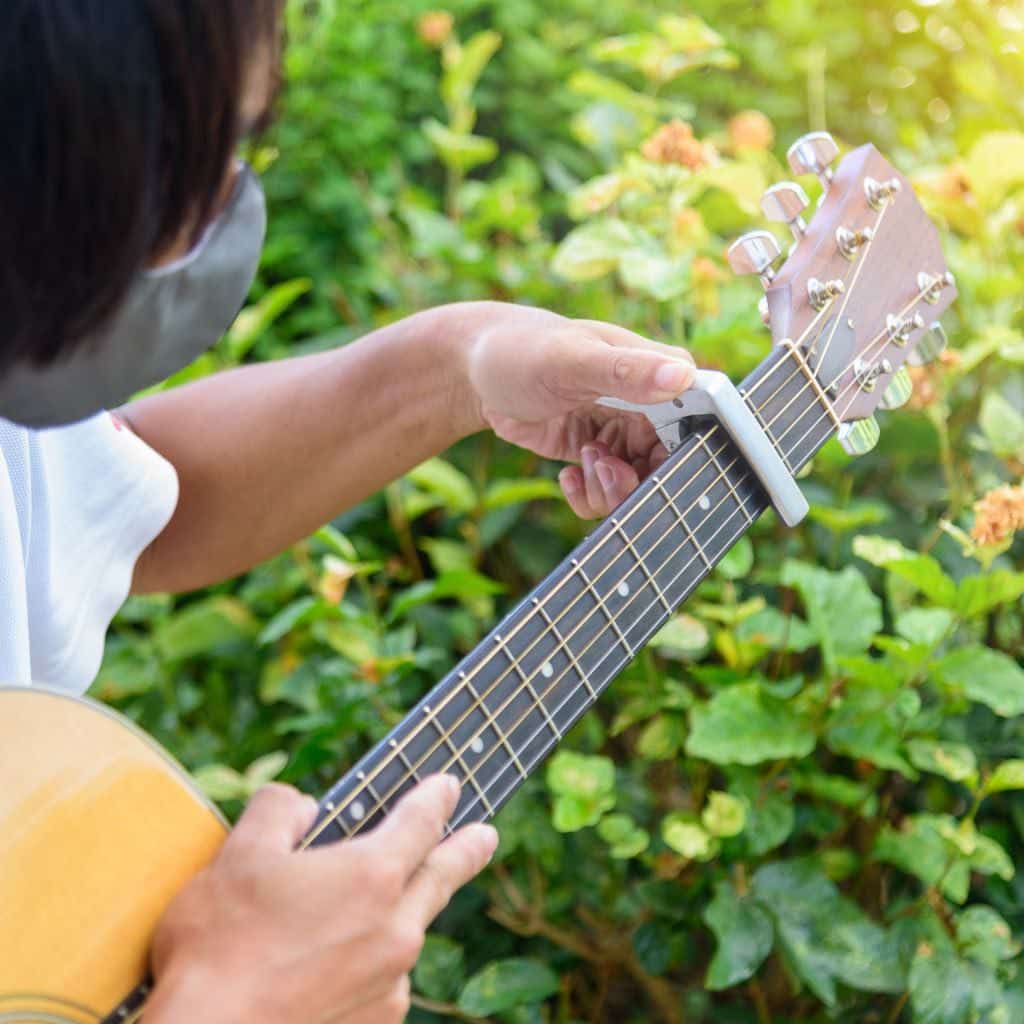
The Bottom Line – To Capo or Not to Capo?
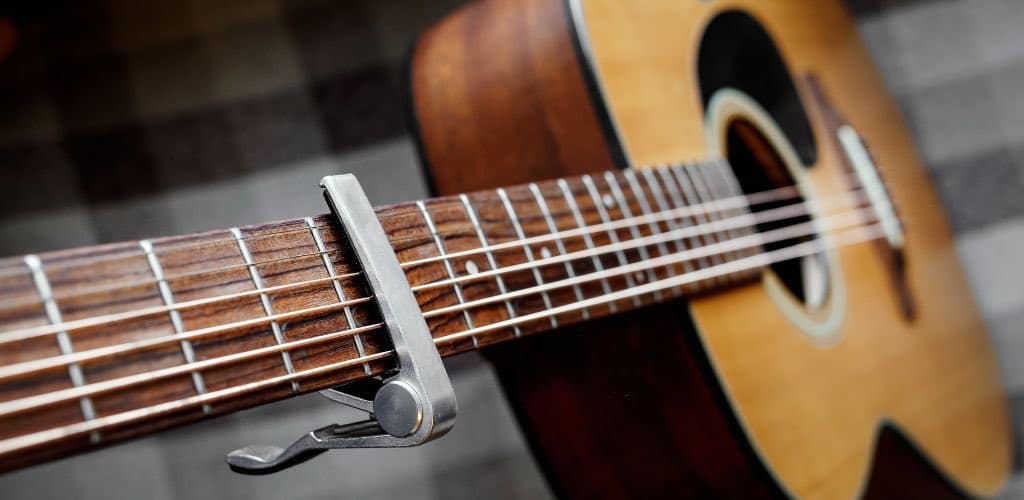
So, what’s the final verdict on leaving a capo on your guitar?
Moderation is Key: While it’s not inherently wrong to leave a capo on for a short time, moderation is key. If you find yourself using it frequently, consider taking it off when you’re done playing.
Listen to Your Guitar: Your guitar will often tell you if something’s wrong. If you notice tuning issues or changes in playability, it might be time to give your instrument a break from the capo. Pay attention to intonation as well, as it can be affected by prolonged capo use.
Enjoy the Benefits: Remember, a capo is a fantastic tool that can enhance your playing experience. Embrace its benefits while being mindful of its potential drawbacks.
Best Capo Recommendation
Shubb C1 Steel String Guitar Capo, Polished Nickel

PERFECT FOR: steel string guitars
FEATURES: With a stylish finish that will complement almost any guitar finish
OTHER INFO: Has an intuitive design for smooth operation
Shubb C1 Steel String Guitar Capo, Polished Nickel
- With superb Shubb quality for a performance that glides effortlessly
- Ideal for exploring music
- More costly than competing brands
When you click ‘Check Price’, you’ll see there are loads of great places to buy this item. Our personal favorite is Sweetwater for the US, and Thomann and Gear4Music for the UK & Europe.
They are the largest music retailers, with excellent customer service, competitive prices, really fast shipping, and the longest guarantees.
The professional musician who wrote this article combined many things,
from the product build, manufacturer’s reputation through to feedback
from other users, to create our famous TedScore™.
Ortega OCAPO-CR Nylon String Capo, Chrome
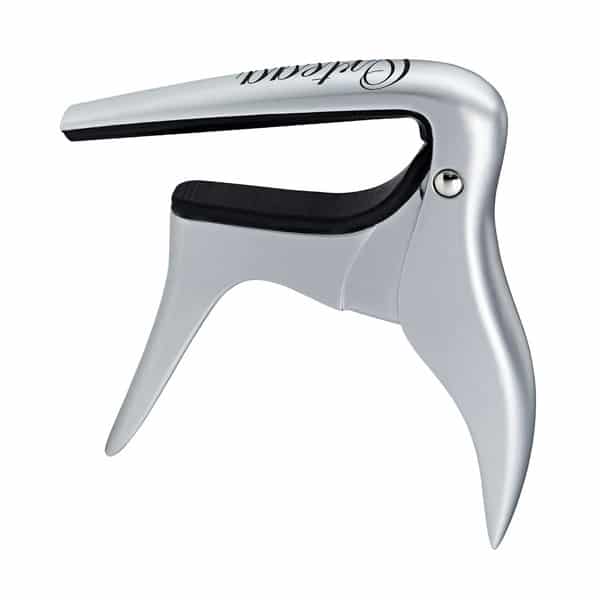
DESIGNED FOR: Beginner to advanced classical guitarists
OTHER INFO: Maximum Width: 52mm
FEATURES: Robust zinc construction
Ortega OCAPO-CR Nylon String Capo, Chrome
- Allows you to adjust your guitar's tuning quickly and easily
- Durable
- Rubber cushion fits comfortably around the neck and fingerboard
- Curved design for improved fretboard contact
- May not fit the width of all classical guitars
- Not compatible with steel string guitars
When you click ‘Check Price’, you’ll see there are loads of great places to buy this item. Our personal favorite is Sweetwater for the US, and Thomann and Gear4Music for the UK & Europe.
They are the largest music retailers, with excellent customer service, competitive prices, really fast shipping, and the longest guarantees.
The professional musician who wrote this article combined many things,
from the product build, manufacturer’s reputation through to feedback
from other users, to create our famous TedScore™.
Dunlop 83CB Trigger Capo, Acoustic Curved, Black
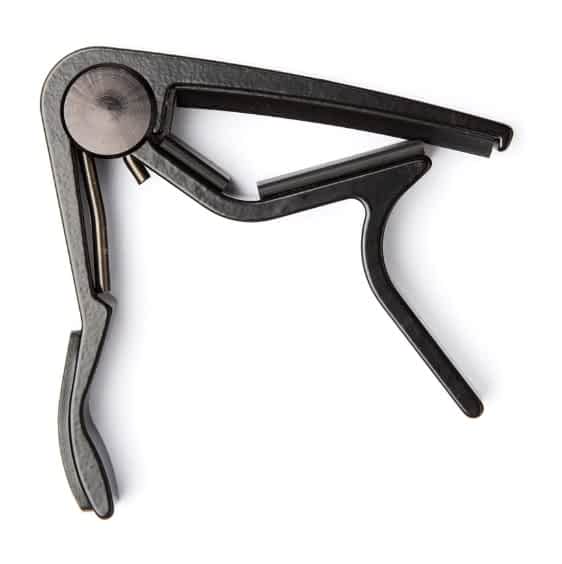
PERFECT FOR: 6 or 12-string acoustic guitars
FEATURES: Boasts outstanding durability with its aircraft-quality aluminium
OTHER INFO: Comes with padding to ensure your guitar's safety
Dunlop 83CB Trigger Capo, Acoustic Curved, Black
- Provides secure clamping
- Super easy to use thanks to smooth spring-action
- A little more pricey compared to other brands
When you click ‘Check Price’, you’ll see there are loads of great places to buy this item. Our personal favorite is Sweetwater for the US, and Thomann and Gear4Music for the UK & Europe.
They are the largest music retailers, with excellent customer service, competitive prices, really fast shipping, and the longest guarantees.
The professional musician who wrote this article combined many things,
from the product build, manufacturer’s reputation through to feedback
from other users, to create our famous TedScore™.
Capo Care:
Is it bad to leave a capo on a guitar?
When playing guitar, it’s essential to consider how the guitar neck interacts with various accessories, such as a capo.
If you frequently use a capo clamped onto the neck, be mindful of how long you leave the capo in place, as it can affect the tension on the guitar strings and impact intonation. For those who struggle with barre chord, a capo can be a helpful tool to simplify playing in different keys.

However, after your practice session, it’s best to remove the capo to avoid unnecessary pressure on the neck. When you’re not using your guitar, placing it on a sturdy guitar stand can help maintain its condition and keep the neck in good shape.
By taking these precautions, you can ensure your guitar remains in top form while you enjoy your playing experience. Ultimately, while a capo is a fantastic tool for expanding your musical creativity, being mindful of its effects on your instrument is essential for maintaining its health.
So, enjoy the benefits of your capo, but remember to treat your guitar with the care it deserves!
Don’t go yet! There’s more…
If you’re looking to enhance your playing experience, check out our article “What Is The Best Guitar Capo For Electric Guitar?” for a comprehensive guide on the top capos that will perfectly complement your electric guitar!
FAQ's
Capos do not inherently damage guitars, but leaving one on for extended periods can create unnecessary pressure on the strings and neck, potentially affecting tuning stability and neck relief. Additionally, prolonged use may lead to uneven fret wear or rubber residue on the strings and fretboard. To prevent any issues, it’s best to remove the capo when not in use and regularly check your guitar for any signs of wear.
While you can technically store a guitar with a capo on, it’s not recommended for long-term storage. Keeping a capo on can create unnecessary pressure on the strings and neck, potentially leading to tuning issues or neck warping. It’s best to remove the capo to ensure your guitar remains in optimal condition.
Tuning your guitar with a capo on isn’t ideal, as the capo can alter the tension on the strings and affect the tuning accuracy. It’s best to remove the capo before tuning to ensure that your guitar is properly adjusted and to avoid any potential issues with intonation. However, if you need to tune while using a capo, just be aware that it may not provide the most accurate results.
It’s best to keep your capo in a convenient and accessible place, such as in your guitar case or gig bag, so you can easily grab it when needed. Some musicians prefer to attach it to the guitar’s headstock or use a dedicated capo holder on their music stand for quick access. Just ensure it’s stored in a way that prevents any damage to your guitar or other gear.










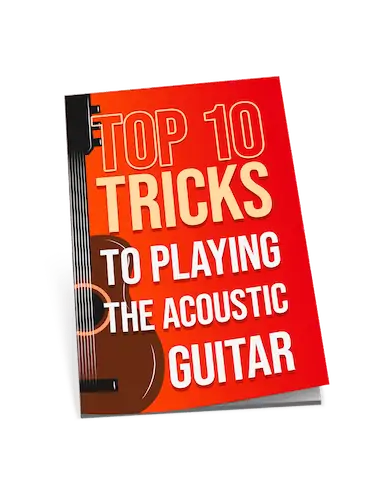
Great article! Always wondered if a capo could harm my guitar. Good to know how to use it properly!🙂
I’m not entirely convinced about the risks of leaving a capo on. I have been playing guitar for years and never once encountered an issue with strings or the neck of my guitar due to a capo being left on. While I understand the theoretical concerns, I believe the real-world impact is minimal. However, I’m open to hearing more about it if there’s concrete evidence to suggest otherwise.
so about leaving a capo on, i’ve done it tons of times, never really thought much about it. but reading this got me thinking maybe i should start taking it off more often, don’t wanna mess up my guitar’s neck or anything. good looking out with the advice.
Hey Hugh Richardson, quick q: does the type of capo matter for beginners like me? I saw the part about the variable tension capo and was wondering if it’s a must-have or just nice to have. Thanks!
Hey EllieR, A variable tension capo is great for starting out, helps prevent string buzz and you can experiment with it on different frets. Worth a try!